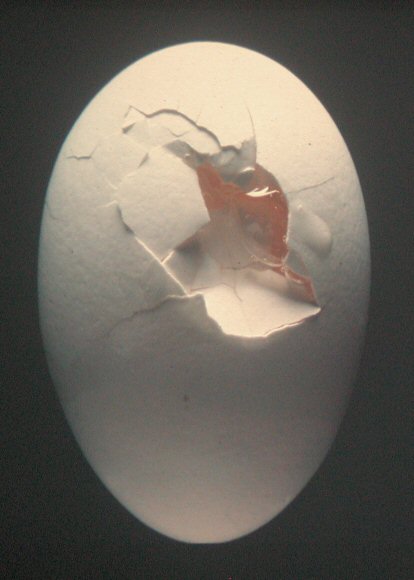Weak Shelled Eggs and Your Small Flock of Laying Hens
The mess left behind by broken eggs is an obvious reason for you to care about the shell quality of the eggs laid by your hens. A less visible reason is the higher level of salmonella found in cracked compared to intact eggs – especially if they are improperly washed.
The most common causes of weak shells eggs in your flock are:
- Old Hens – Shell strength declines steadily as hens get older. If you buy old hens from a commercial farm, they are already well past their prime for shell quality.
- Calcium Deficiency – To supply the calcium needed to make good shells, 10% of the feed must be supplied as limestone or oyster shell. For birds in floor pens, a hanging feeder of limestone or oyster shell can be used as the calcium source. When a layer diet is used as the sole source of calcium, restricted feed consumption due to crowding and other problems can also restrict calcium intake.
- Poor Calcium Sources – Insoluble granite grit and egg shells are poor sources.
- Excess Phosphorous – Too much phosphorous in the diet will decrease shell thickness. If you make your own feed, carefully weigh out the amount of mineral phosphorous.
- Early Production – Hens that begin egg production before you get them on a good layer diet can rapidly deplete their bone reserves of calcium.
- High Temperature – Temperature over 32°C stresses the hens and reduces shell strength.
- Vitamin D3 Deficiency – Hens need a commercial source of vitamin D3 in the feed. Deficiency is most visible in the winter months when the birds get less sunlight and make less vitamin D3 on their own.
- Infectious Bronchitis – This virus readily attacks the shell gland of unvaccinated birds.
- Excitable Hens – Hens that are excited may produce thin or poorly constructed shells.
Less common problems include insufficient manganese in the feed, toxins or pesticides, and miscellaneous diseases such as coccidiosis and Infectious Laryngotracheitis (ILT).
Shell quality can be improved by providing the nutrients needed for the hen to build her bone reserves of calcium and make good shells:
- Feed a third to half of the calcium as large particles that are approximately ½ cm in size. Both oyster shell and limestone the size of small pebbles will last longer in the gizzard and supply calcium at night when the hen makes the shell.
- Supply a pre-lay diet containing 2% calcium for the two weeks prior to the start of egg production. Due to hormonal changes as the birds ready for egg production, they are able to use the extra calcium to build up their bone reserves. A hanging feeder of limestone or oyster shell is another way to give the birds access to the calcium they need.
- Switch the flock immediately to a laying diet which has 3.5% or more calcium when you see the first egg laid by the flock. Approximately 10% of the diet must be limestone or oyster shell to provide this much calcium
- Let the hens will pick limestone or oyster shell as they need it from a hanging feeder. See the MAFRI web page on choice feeding.
- Give vitamin D3 in the water one day a week. Follow the package instruction and do not add more vitamin D3 than recommended.
- Keep your birds calm. Do not give them more than 16 hours of daylight. Letting them sleep longer will keep them calm during the time of day when they are forming the shell.
These practices will not stop the natural weakening of the shells as your hens age but will help to prevent any premature problems. If your old hens go into a moult, shell thickness will be temporarily improved.

Weak Shells can lead to cracks & "Leakers"/ Photo- University of Georgia Cooperative Extension Service

